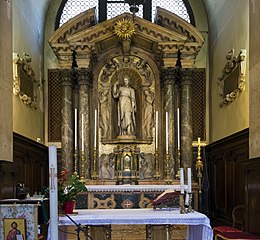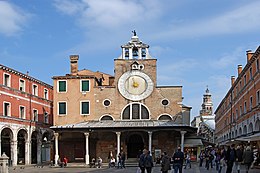San Giacomo di Rialto

San Giacomo di Rialto ( San Giacometto ), a Venetian church in the San Polo district , was originally built in the High Middle Ages, probably in the late 11th or early 12th centuries. In Renaissance literature , however, it was considered a building from late antiquity and was viewed as the model of San Marco . With the legendary laying of the foundation stone in 421, the city of Venice should have been founded after the idea of the Renaissance.
Various structural measures have been handed down since the 14th century. In 1341, for example, the roof overhang or structure ("revetenum coporum") provided with roof tiles was to be provided with rain gutters . Both sides of the loggia that did not yet have gutters should also be equipped with appropriate rain gutters. In 1393 the still quite new bell tower ( campanile ) was to receive a new clock , a striking clock with a wheel train, which was called "orologio latino". It should have a clapper three times the size of the previous model. In 1394 the church received a new bell called Rialtinafrom now on, when it rings, it should indicate the start and end of work throughout the city. Finally, the square in front of the church should be repaved, especially since traders, nobles and strangers met and stayed there. The remains of the old campanile should also be torn down, as well as the officium ponderis (a kind of calibration office ) and the exchange office (cambio) there, in order to build a beautifully covered hall. So the said should be able to gather and run their business even in bad weather - in addition, the square in the famous (famosa) city should be “beautiful” (pulcher) and “large” and “decorated”.
After the Rialto fires in 1531 and 1601, the church was renovated. The current building is a new construction of the medieval complex from the year 1601, copying the old disposition, in which the columns of the destroyed church were reused. The ground was raised significantly to protect against flooding. The rich mosaics of the vaults, which are still documented in older sources, were lost.
The church is known for the large 15th century clock that sits above the entrance. Among the furnishings , a James by Alessandro Vittoria and the bronze statue of Antonius Eremita by Girolamo Campagna , donated by the goldsmiths, are worth mentioning.
literature
- Deborah Howard: The architectural history of Venice. Revised and expanded edition. Yale University Press, New Haven CT / London 2002, pp. 14-17. ISBN 0-300-09029-3
- Herbert Rosendorfer : Church leaders Venice. Edition Leipzig, Leipzig 2008, p. 53 f. ISBN 978-3-361-00618-8
Web links
Remarks
- ↑ Hubertus Günther: The ideas of the Greek temple and the beginning of the Renaissance in Venetian architecture , in: Naredi-Rainer, Paul von (ed.): Imitatio. On the productivity of artistic allusions and misunderstandings , Berlin 2001, pp. 104–143.
- ^ Antje Middeldorf Kosegarten: Local legislation, building planning and urban aesthetics in medieval Venice , in: Michael Stolleis, Ruth Wolff (ed.): La bellezza della città. City law and urban design in Italy during the Middle Ages and the Renaissance , Max Niemeyer, Tübingen 2004, pp. 93–134, here: p. 122.
- ↑ Because there “super continuo se reducunt et conversantur nobiles et mercatores nostri ac generaliter omnes forenses huc undique accedentes” (quoted from: Antje Middeldorf Kosegarten: Municipal legislation, building planning and urban aesthetics in medieval Venice , in: Michael Stolleis, Ruth Wolff (ed. ): La bellezza della città. Urban law and urban design in Italy in the Middle Ages and the Renaissance , Max Niemeyer, Tübingen 2004, pp. 93–134, here: p. 123).
- ↑ Deborah Howard: The architectural history of Venice , revised and expanded edition, Yale University Press, New Haven / London 2002, pp. 14-17.
Coordinates: 45 ° 26 ′ 18.5 ″ N , 12 ° 20 ′ 7.7 ″ E

